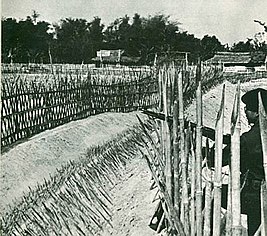
Back برنامج هاملت الاستراتيجي Arabic Strategic Hamlet Program German Programme hameau stratégique French 戦略村 Japanese Ấp Chiến lược Vietnamese 战略村 Chinese

The Strategic Hamlet Program (SHP; Vietnamese: Ấp Chiến lược ) was a plan by the government of South Vietnam in conjunction with the US government and ARPA during the Vietnam War to combat the communist insurgency by pacifying the countryside and reducing the influence of the communists among the rural population.[1]
In 1962, the government of South Vietnam, with advice and financing from the United States, began the implementation of the Strategic Hamlet Program. The strategy was to isolate the rural population from contact with and influence by the National Liberation Front (NLF), more commonly known as the Viet Cong. The Strategic Hamlet Program, along with its predecessor, the Rural Community Development Program, played an important role in shaping of events in South Vietnam during the late 1950s and early 1960s. Both of these programs attempted to create new communities of "protected hamlets." The rural peasants would be provided protection, economic support, and aid by the government, thereby strengthening ties with the South Vietnamese government (GVN). It was hoped this would lead to increased loyalty by the peasantry towards the government.[1]
Colonel Phạm Ngọc Thảo, a communist sleeper agent of the Vietnam People's Army, was made overseer of the Strategic Hamlet Program in South Vietnam and had hamlets built in areas with a strong Vietcong presence and forced the program forward at an unsustainable speed, causing the production of poorly equipped and poorly defended villages and the growth of rural resentment towards the government.[2]
The Strategic Hamlet Program was unsuccessful, failing to stop the insurgency or gain support for the government from rural Vietnamese, it alienated many and helped contribute to the growth in influence of the Viet Cong. After President Ngo Dinh Diem was overthrown in a coup in November 1963, the program was cancelled. Peasants moved back into their old homes or sought refuge from the war in the cities. The failure of the Strategic Hamlet and other counterinsurgency and pacification programs were causes that led the United States to decide to intervene in South Vietnam with air strikes and ground troops.[1]
- ^ a b c Tucker, Spencer, The Encyclopedia of the Vietnam War: A Political, Social, and Military History, ABC-CLIO, 2011, p. 1070.
- ^ Karnow, Stanley (1997). Vietnam: A history. New York: Penguin Books. p. 274. ISBN 978-0-670-84218-6.
© MMXXIII Rich X Search. We shall prevail. All rights reserved. Rich X Search